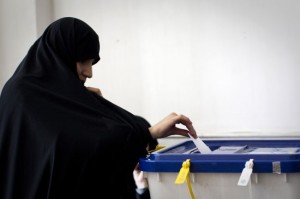 The list of candidates registered for the Iranian presidential�election�in June � at least until they are trimmed by the Guardian�Council � offers Iranian voters a reasonable variety of philosophies from which to choose.
The list of candidates registered for the Iranian presidential�election�in June � at least until they are trimmed by the Guardian�Council � offers Iranian voters a reasonable variety of philosophies from which to choose.As usual, there is a mix of social and economic issues on voters� minds, but�differences between candidates�in their approaches to solving Iran�s mounting economic problems matter most. Populists, led by president Ahmadinejad�s close associate Esfandiar Rahim Mashaie, promise more redistribution. Pragmatists and reformers, led by former President Hashemi�Rafsanjani, argue for the revival of economic growth. Finally, an assortment of conservatives, led by politicians close to the Supreme Leader, such as former Foreign Minister Ali Akbar Velayati, Tehran Mayor Mohammad Bagher Ghalibaf and nuclear negotiator Saeed Jalili, will take a middle course promising both growth and redistribution.
But who are the voters to whom these philosophies would appeal?
Since the last election in 2009, the voting-age population (18 years and older) has grown from 47 million to 55 million. (Age structure and employment data are calculations from the 2% sample of the 2011 census provided by the Statistical Center of Iran and are adjusted to reflect the 2013 age structure.)�It has also aged slightly: The median voter is now 38 years old, three years older than in 2009. Voters under 30 (henceforth young voters), account for one-third of all voters, down from 37% in 2009. So, young voters are not as numerous as they were in 2009 when, in the aftermath of the highly contested vote that returned Ahmadinejad to office for a second term, they poured into the streets and created the Islamic Republic�s first serious political crisis. But, compared with 19% in the US, Iran's young voters are still quite a force to be reckoned with.
The shift to adult voters (aged 30-64), who comprise 57% of all voters, compared to 54% in 2009, though small, points to the direction in which Iranian politics may be moving in the future: away from social issues that concern youth and in the direction of economic issues that matter to older voters. In 2009, younger voters were energized by Mir Hossein Mousavi�s statement during a television debate that, if elected, he would stop the�public chastity police. They seemed less concerned that his economic plan was much less specific about how he was going to help them find jobs.
Older voters are more concerned with economic issues because they work and are breadwinners for their families. Youth suffer from very high rates of joblessness, but their pain is often shifted to their parents. An astonishing 65% of young voters live with their parents, and are thus partly shielded from the harshest aspects of Iran�s failing economy. About 77% of adult males work, compared to 40% for young voters (11% of adult women work compared to only 6% of young women).
Social class will play a larger role in this election than any in the past, thanks in part to the populist policies of the Ahmadinejad administration. In 2011, the median voter lived in a family with about $11 per day of expenditures per person, which by common international standards classifies him or her as middle class. (Conversions to US dollars use a factor of 6,500 rials in 2011, which is higher than the World Bank estimate of 5,854 rials per USD; income and expenditure data use the Expenditure and Income Surveys of 2009 and 2011 collected by the Statistical Center of Iran.)
Poor voters (defined as living in families with less than $3 per day) accounted for only 2.1% of the voting age population. But rising inequality, especially at the very top, has created a much wider base of disgruntled voters who would like to see the government engage in more redistribution, not less, despite the fact that many in Iran now believe that Ahmadinejad-style redistribution has caused inflation and not improved their lot.
Since January 2011, President Ahmadinejad�s main populist program � cash instead of�energy subsidies�� has been depositing cash in individual bank accounts of nearly every Iranian every month. Survey evidence suggests that for people below the median income, trading cheap fuel for cash has been a net gain. The monthly payment amounted to $360 (in international dollars) for a family of four in 2011, which was about 50% of the monthly expenditures of people in the poorest 10% (now about half as much), 17% for those in the middle of the distribution, but only 5% for the richest decile. As a result of these and other transfers, the Gini index of income distribution fell by nearly 5 percentage points to 0.36 (my calculations from surveys of incomes and expenditures), its lowest level in the post-revolution period.
Improving the distribution of incomes is not the same thing as raising them. In the last two years, Iran�s economy has performed very badly, in part because of international sanctions, but also in large part because crude redistributive policies, such as unconditional cash transfers, are rarely good for economic growth.
Even if Esfandiar Rahim Mashaei, the candidate most closely associated with Ahmadinejad, is allowed to run, it is uncertain whether or not he will be able to rally the beneficiaries of the populist policies followed in the last eight years to make a good showing at the polls. Uncertain, too, is how long his reformist and conservative opponents can afford to ignore popular demands for redistribution or be able to undo the redistributive policies of the current administration if they win the election.
By Al-Monitor
The Iran Project is not responsible for the content of quoted articles.










